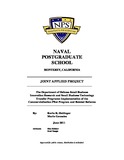The Defense small business innovation research and small business technology transfer programs: implementation of the commercialization pilot program and related reforms
| dc.contributor.advisor | Kidalov, Max | |
| dc.contributor.advisor | Naegle, Brad | |
| dc.contributor.author | Hettinger, Kevin R. | |
| dc.contributor.author | Gonzalez, Mario | |
| dc.date | June 2011 | |
| dc.date.accessioned | 2012-08-22T15:33:30Z | |
| dc.date.available | 2012-08-22T15:33:30Z | |
| dc.date.issued | 2011-06 | |
| dc.identifier.uri | https://hdl.handle.net/10945/10757 | |
| dc.description | Joint Applied Project | en_US |
| dc.description.abstract | In Section 252 of the National Defense Authorization Act for Fiscal 2006, "Research and Developments Efforts for purposes of Small Business Research," Congress adopted four wide-ranging reforms to the Defense Small Business Innovation Research (SBIR) and Small Business Technology Transfer (STTR) programs in order to increase the effectiveness of SBIR and STTR for both the DoD and the defense industry. First, Section 252 directed closer alignment between RandD and acquisition goals of SBIR and STTR. Second, Section 252 authorized and funded creation by the Defense (DoD) and the military services of the Commercialization Pilot Program (CPP) to facilitate transition of SBIR technologies into the acquisition process. Congress conditioned the use of CPP funds on detailed evaluative reporting to Congress. Third, Congress codified into statutory law President George W. Bush's Executive Order 13329, Encouraging Innovation in Manufacturing, which incentivized manufacturing technologies through the SBIR and STTR programs. Fourth, Congress clarified the authority to conduct testing and evaluation of SBIR and STTR technologies in SBIR and STTR Phases II and III. The implementation requirements were specified in the text of Section 252 and the Congressional Guidance Letter issued by the House and the Senate Small Business Committees. This study analyzes the implementation of Section 252 by the Secretaries of Defense, the Army, the Navy, and the Air Force. It reflects the results of literature review and a survey of SBIR and STTR program executives The study questions are based on Section 252 text and the Congressional Guidance letter, as well as best practices identified in relevant academic and professional literature. The study finds that, while the DoD and the military departments have begun implementation of the DoD SBIR CPP program and other Section 252 reforms, progress is uneven. Specifically, agencies are not implementing section 252 CPP incentives and RandD alignment requirements to the fullest extent possible. The study recommends clarifications of legislative requirements and additional review of Section 252 implementation. | en_US |
| dc.description.uri | http://archive.org/details/thedefensesmallb1094510757 | |
| dc.format.extent | xvi, 94 p. ; 28 cm. | en_US |
| dc.publisher | Monterey, California. Naval Postgraduate School | en_US |
| dc.rights | This publication is a work of the U.S. Government as defined in Title 17, United States Code, Section 101. Copyright protection is not available for this work in the United States. | en_US |
| dc.subject.lcsh | Research | en_US |
| dc.title | The Defense small business innovation research and small business technology transfer programs: implementation of the commercialization pilot program and related reforms | en_US |
| dc.contributor.department | Graduate School of Business & Public Policy (GSBBP) | |
| dc.subject.author | SBIR | en_US |
| dc.subject.author | Small Business Innovation Research | en_US |
| dc.subject.author | STTR | en_US |
| dc.subject.author | Small Business Technology Research | en_US |
| dc.subject.author | CPP | en_US |
| dc.subject.author | Commercialization Pilot Program | en_US |
| etd.thesisdegree.name | Master of Science in Program Management | en_US |
| etd.thesisdegree.discipline | Program Management | en_US |
| etd.thesisdegree.grantor | Naval Postgraduate School (U.S.) | en_US |
Files in this item
This item appears in the following Collection(s)
-
1. Thesis and Dissertation Collection, all items
Publicly releasable NPS Theses, Dissertations, MBA Professional Reports, Joint Applied Projects, Systems Engineering Project Reports and other NPS degree-earning written works. -
6. Capstone Applied Project Reports; Joint Applied Project Reports





